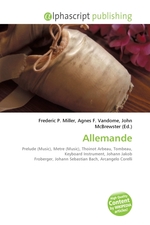Allemande
Frederic P. Miller, Agnes F. Vandome, John McBrewster
бумажная книга
Please note that the content of this book primarily consists of articles available from Wikipedia or other free sources online. An allemande (also spelled allemanda, almain(e), or alman) (from the French word for "German") is one of the most popular instrumental dance forms in Baroque music, and a standard element of a suite. Originally, the allemande formed the first movement of the suite, before the courante, but, later, it was often preceded by an introductory movement, such as a prelude. The allemande originated in the 16th century (Renaissance) as a duple metre dance of moderate tempo, derived from dances supposed to be favoured in Germany at the time. No German dance instructions from this era survive, but 16th century French (Arbeau) and British (Inns of Court) dance manuals for the Almain do survive. In general the dancers formed a line of couples, extended their paired hands forward, and paraded back and forth the length of the room, walking three steps, then balancing on one foot; a livelier version, the allemande courante, used three springing steps and a hop.
Данное издание не является оригинальным. Книга печатается по технологии принт-он-деманд после получения заказа.


